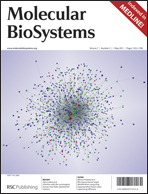Contribution of gross chromosomal changes to HPV16-induced transformation†
Abstract
Cervical cancer is initiated by infection with high-risk human papillomavirus (HPV). The viral E6 and E7 oncogenes are required for the initiation of cervical epithelial cell immortalization, but do not suffice to cause cervical cancer. Human oncogenes and tumor suppressor genes with altered activity in cervical carcinoma have been recognized, but none of these appears to be an absolute precondition for the development of the cancer. To examine the contribution of chromosomal aberrations to the development of cervical carcinoma, we used an in vitro model system consisting of primary keratinocytes (K) and papillomavirus transformed keratinocytes from early (E) and late (L) passages and from


 Please wait while we load your content...
Please wait while we load your content...